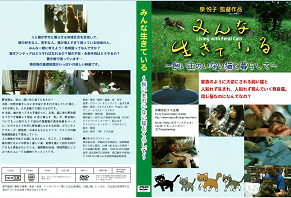Living with Feral Cats with English-subtitled (2014/91min/color/stereo)
While domestic cats are loved and protected as part of the family, feral
cats live and die neglected and unnoticed. But
why is there so much difference? Feral, stray or tame, they are all cats. They
are all alive. Trailer

Feral cats are pet cats abandoned by their owners, or descendants of pet
cats who are free to go around without being spayed or neutered. They are cats forsaken by people.
First, my daughter brought home Evi, a
kitten her friend found abandoned in a parking lot. Nine years on, I now have four cats at home, because I have taken
in more and more feral cats that wandered into our garden. In this documentary I tried to chronicle my
days with those cats as they grew from kittens to adults; I also went visiting
with a video camera in hand government facilities and workshops, volunteer
groups, and vets—and my quest even took me to animal shelters in Germany and
the U.S.A.
With the upcoming 2020 Tokyo Olympics, more and more old buildings are
being pulled down.
That means that feral cats that currently stay in those buildings will
no longer be able to live there. And so
I had to make this film. We should
learn to live with cats. We should find
a way.
If you love cats or hate them, if you
live in an area with an excessive and increasing population of cats, if you
wish to learn more about the community cats movement or to know what exactly a
“cat volunteer” does, then this film is for you. It gives you the very basic information about feral cats and what
we can do for them. (Photo: Cats seen inside a cabin located in a cat colony in Portland, Oregon)
| What’s new DVD on Sale! For detail, please click here.
|
![]()
About the director
|
“Living with Feral Cats” is the latest documentary by the award-winning filmmaker Etsuko Izumi. Izumi is most known for “Psychologist Tsuruko Haraguchi – Memories of Her Days at Columbia University in the Early 1900s,” winner of the 2008 Yamaji Fumiko Film Award, which brought back to life memories of Japan’s first ever woman psychologist Tsuruko Haraguchi who studied in Columbia University at the turn of the century and so prematurely died at age 29. |
|
About “Living With Feral Cats”
Etsuko Izumi
Before my daughter
came home with a kitten her friend found abandoned in a parking lot, I had a
dog, Toto. He had also been brought
home by the same daughter. I held him
in my arms when he left this life at 15 years and 8 months of age. At that time, I was an extremely busy
working mother, struggling under the responsibilities of bringing up three
children singlehandedly. So I hardly ever had time for Toto. He was almost
always alone in our garden. After he
passed, I had an overwhelming sense of remorse and guilt. I had let him spend his entire life out in
the cold and never let him inside. And
so when the kitten came to live with us, I was determined to keep him in the
house and give him a warm shelter from elements.
Five years after we
found Evi, we caught Shima, a feral female that wandered into our garden. She egested all kinds of worms from
roundworms to tapeworms. As a feral,
she must have been constrained to eat anything and everything. What a will to survive! I could not but be impressed by this
frail-looking female.
Our fourth cat was a
male cat and we named him Kuro (meaning “Black” in Japanese). We were shocked when we found that he was
infested with AIDS and leukemia. The
vet told us that the diseases had not been passed on to him by his mother, but
the infestation must have been the result of fighting or mating.
If Kuro had been
neutered, he might not have fought or mated and might not have become infested.
When I made up my mind to keep Kuro as
a member of my cat family, I also decided to make a film that would help the
world know the fundamentals about feral cats. I also wanted to record the efforts of volunteers, veterinarians,
and government workers who are trying 24/7 in order to save and help cats. I also wanted to collect information and meet
people in the U.S.A. where as in Japan the government euthanizes cats and in Germany
where euthanizing is banned by the government. And the film just grew and grew.
While love of “kitties”
is very much a part of our childhood, as we grow older, we learn to
discriminate adorable pets from unwanted strays that present sanitary hazard. Why can we no longer cherish them as we once
did? Are they really filthy creatures? What are they really like? The answers to these questions have not been
readily available.
It is not yet widely
known that in Japan approximately 180,000 cats, including fit and healthy ones,
are “humanely killed” before their time every year, by the government using
carbon dioxide gas. When you next see a
feral cat in the street, I would like you to remember this film.
 |
Etsuko Izumi - Biography: In 2007, “Psychologist Tsuruko Haraguchi—Memories of Her Days at Columbia University in the 1900s” was completed. The film was invited to take part in the official selection of Tokyo International Women’s Film Festival, Aichi International Women’s Film Festival, Takasaki Film Festival, and Cameroun International Women’s Film Festival among others. In 2009, “Psychologist Tsuruko Haraguchi” was awarded the Fumiko Yamaji Film Award. In 2011, Izumi wrote the drama film “Ekureru,” and in 2014, completed “Living With Feral Cats." |

About screenings
Thank you for your interest in the screening of “Living With Feral Cats.” All films by Tess Planning are independently produced without any sponsorship. The profits from ticket sales, film rental fees, and the DVD sales, etc. will go into the production of our upcoming film projects. So your help could really make the difference!
How to organize a screening
1. Tell us the target audience, purpose, and the budget for the screening you wish to organize; then pick the date and time.
2. Pick the venue.
3. Apply for a private screening.
4. Tell us whether it will be free of admission or not.
5. Make your decisions about the poster, flyer, etc.
6. Check the equipment necessary for the screening.
7. Advertise the screening on your website, bulletin, newspapers, television, or free papers, etc.
8. Once you receive the film, be sure to do the screening test at the venue.
How to apply for the screening
The fee is kept at a minimum so that a screening for a small group of people is also possible. Please pick the time and date, etc., for your screening and let us know. We will get back to you with the details and application form, etc. to make it happen!
Flyers and posters are available. (The flyer has a blank space at the back which can be used to include the information about the organizer, etc.
These will be shipped at additional charge.
* Flyers (B5 in size) - ¥20 a sheet
* Poster (B2 in size) (Currently in production) ¥200 a sheet
* If you wish to make your own flyer or poster, we can send you for free the visual data (jpg. files) which you can use for the purpose.
If you wish to have Director Izumi attend the screening, please let us know. A talk event, etc. can be arranged with a minimal fee and cost of transportation.
Delivery & returning
The film and all necessary materials will be delivered to those in charge of the screening at least a week before the screening.
Please return the DVD (or Blu-ray), etc. to Tess Planning within a week of the screening.
For details and inquiries, please contact: Tess Planning
Phone: 81+3-5991-3486
Email: e-izumi@tessplanning.com

